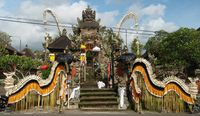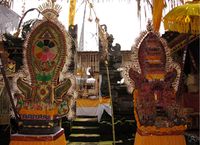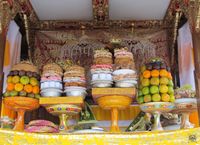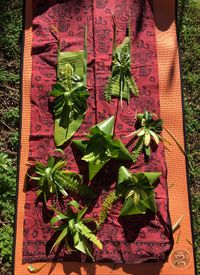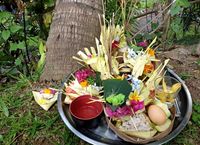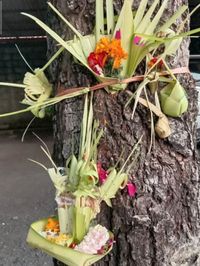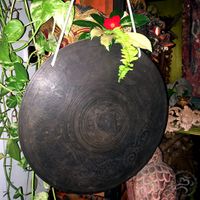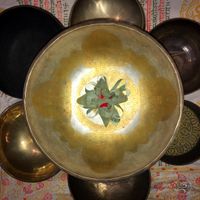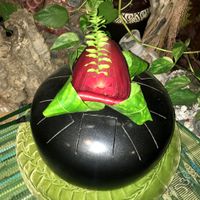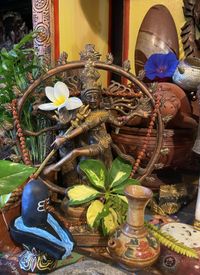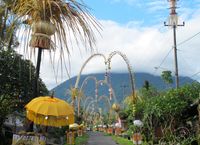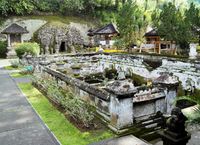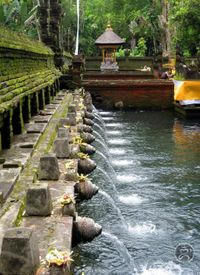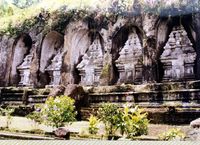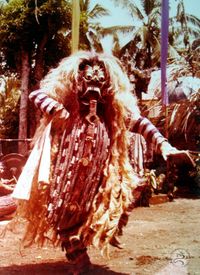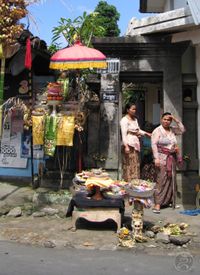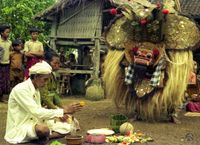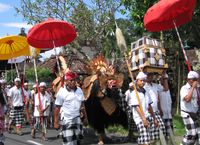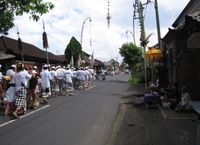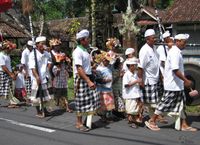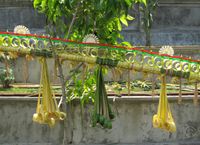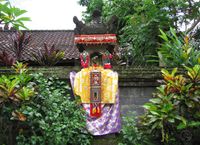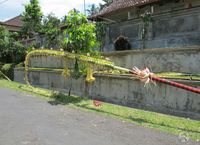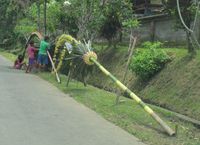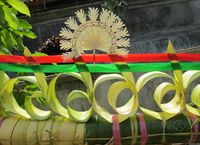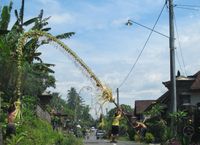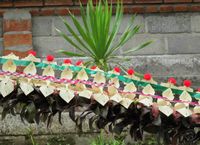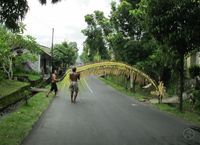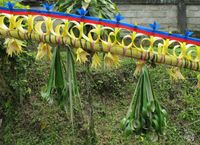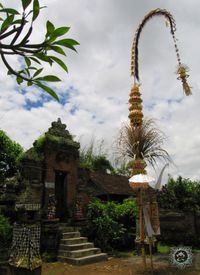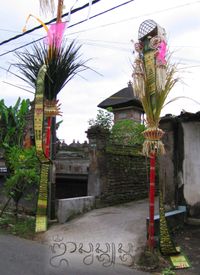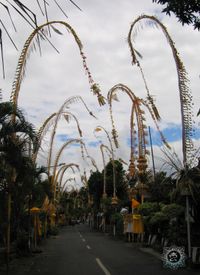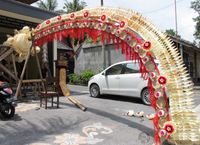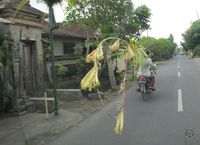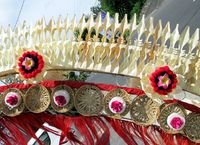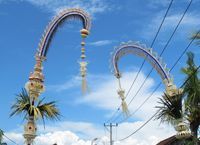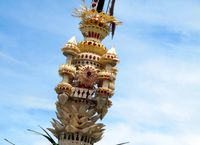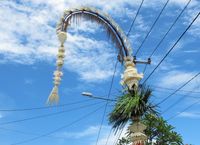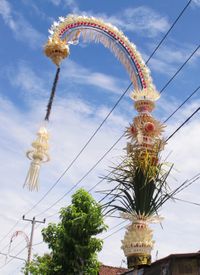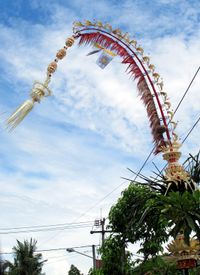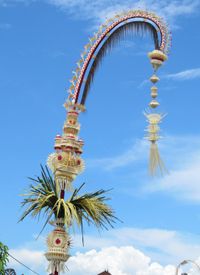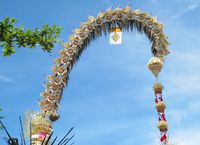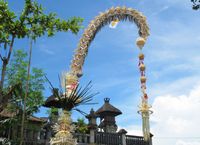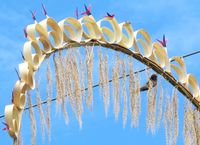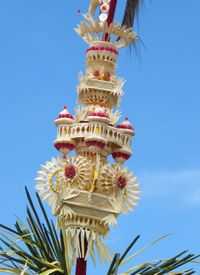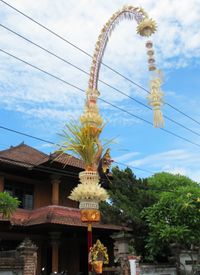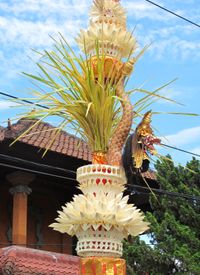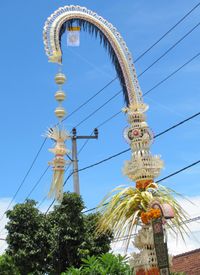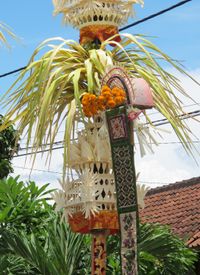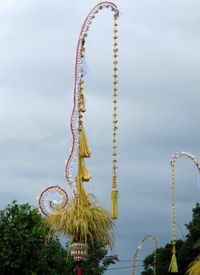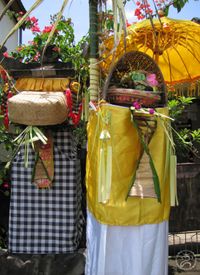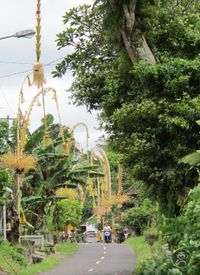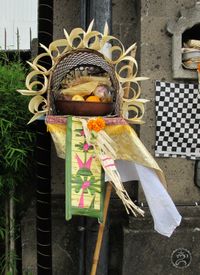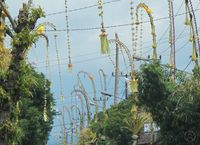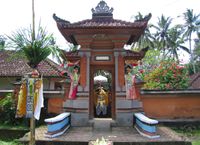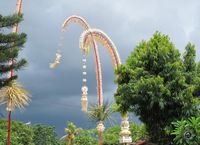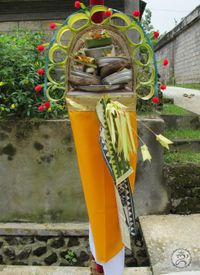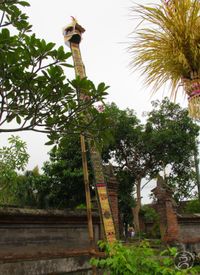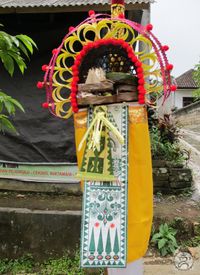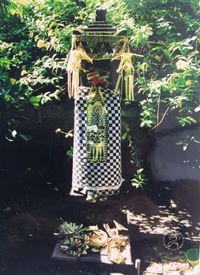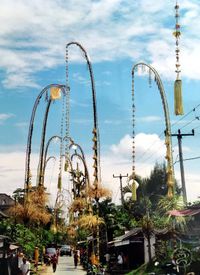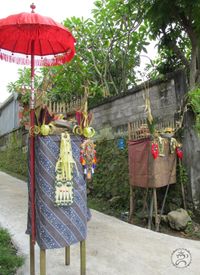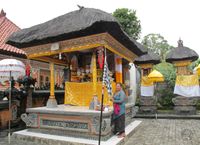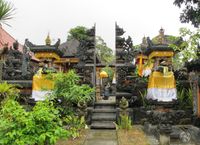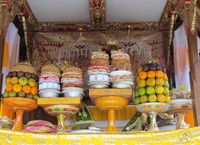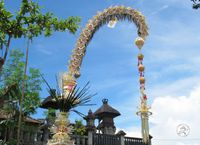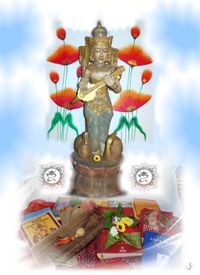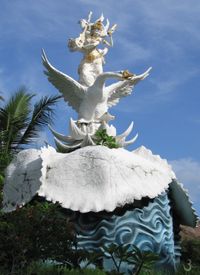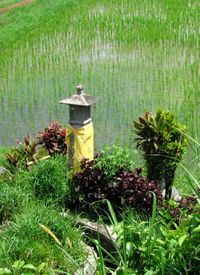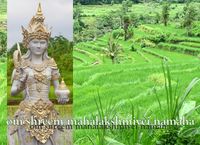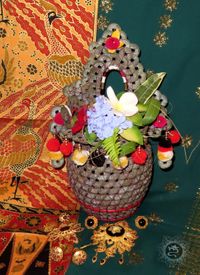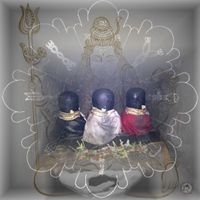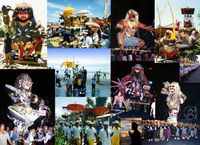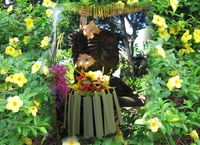“Whosoever offers to me with devotion a leaf, a flower, a fruit, or water,
that offering of love, of the pure heart I accept”
~ Bhagavad-Gita
Bali is the hOMe of my soul ... although I was not born into it in this life. I discovered the island and its religion, art, rites and culture when I was a teenager. And I am grateful that I was able to live there for so many years. The Balinese culture has shaped me. Even now that I am no longer there, the Agama Hindu Bali (next to Osho) flows through my blood. A fascinating culture. The Balinese still live in a magical world that does not distinguish between the physical and the world of gods, ancestors and demons. The festival culture is an expression of this intimate connection with the invisible. The Balinese calendar has 210 days and actually 210 days of celebration! There's always a ceremony going on somewhere on the island! It is very important for the Balinese to adhere to the festival calendar, because they are convinced that this is the only way to ensure the survival of their island and the whole world. Every phase of life has its rituals, every temple has its anniversary, there are festivals for the gods, festivals for the ancestors, festivals for rice (which is actually the manifested form of the goddess Dewi Sri) ... imagine anything - in Bali there is a special ceremony for this! In fact, anything we do or have can be celebrated as something divine. In principle, I also learned this from my beloved Guruji Osho. Everyday activities can be turned into meditation. With the Balinese everything is given by God and they thank him several times a day with small offerings. However, on certain days the celebrations are more complex.
Balinese festivals are celebrated very lavishly. Prepared for days or even weeks. An infinite number of offerings are made collectively. Temple beautifully decorated to receive the gods and ancestors. Huge processions take place. Once you've experienced this, you will never forget it. But behind all this spectacle there are such wise messages. Everything has a meaning and basically the Balinese just show that everything on this earth has a soul. It is a reverence to the divine that dwells in even the little things in life. Good and supposedly demonic are only certain energies of the whole. On this page I describe the ceremonies, but also how you can celebrate the divine in a very personal way. I just want to inspire you.
ceremonies of the Pawukon-Cycle
A "Balinese year" is two hundred and ten days. It consists of a sequence of ten consecutive cycles of varying lengths from one day, two days, three days to ten days. The beginning of the year is always a Sunday, just as the week always begins on Sunday. A "Balinese week" consists of seven days, just like ours. So there are 30 weeks in the calendar that all have a name. It all sounds very complicated, but there are wonderful calendars in Bali, so I could never miss anything back then! The most important festivals are determined by the three, five and seven day group, so that many festivals recur every fifteen or thirty five days.
These are “Kajeng Kliwon”, “Buda Kliwon”, “Anggara Kliwon”, “Buda Cemeng”, “Tumpek”, “Pengembang”, “Galungan & Kuningan”, “Saraswati Watugunung” and “Pagerwesi”.
TUMPEK
Throughout the Pawukon cycle, which lasts two hundred ten days, there are six 35-day cycles that end on a Saturday. These periods and Saturday are called "tumpek". They are assigned to a specific constellation. Every "tumpek" is celebrated with sacrifices and ceremonies for a specific area of life. There is the "Tumpek Landep" for weapons, cars and sharp iron tools, "Tumpek Wariga / Uduh" for crops, "Tumpek Kuningan" for ancestors, "Tumpek Krulut" for sacred sound, dance and love, "Tumpek Uye "for the pets, and the" Tumpek Wayang "for the musical instruments and theater puppets. These days are really auspicious!
TUMPEK LANDEP
Tumpek Landep is a ceremonial day at which offerings are made for objects that are made of metal. The ceremonies start in the morning at the village temple when the Balinese gather for special prayers and blessings. Afterwards additional ceremonies and blessings follow at which offerings are made for the holy family keris (Balinese sword-dagger), but also for cars and motorbikes. In these modern times, also other objects that contain metal, such as computers, may be subject to these ceremonies. Most Balinese people truly believe that these ceremonies and blessings will bring them luck and keep them safe in traffic. And not just the Balinese, I always do that too. I don't drive a car without a mantra, because it's a weapon! Before I work on the laptop, I also recite the Ganesha mantra and always distribute offerings at the most important points in my everyday life. 2020 our car really needs a few offerings after it was at the auto mechanic for over 10 months!!!
Last Tumpek Landep (February 13 th 2021) I was sitting in our garden here in Andalusia/Spain making offerings. Suddenly tears flowed from my eyes, from my soul. I miss Pulau Dewata, the island of the gods, very much. So much love flows in me for this island and so much Bali flows in me ... I have a grieving heart and yet I am grateful that I was allowed to BE there for so long. Bali made me what I am today.
Om Sanghyang Pasupati Ang, Ung, Mang ya Namah swaha.
Om Brahma Astra Pasupati, Visnu Astra Pasupati, Siva Astra Pasupati, Om ya namah svaha.
Om Sanghyang Surya Chandra tumurun maring Sanghyang Aji Sarasvati,
Tumurun maring Sanghyang Gana,
Angawe Pasupati mahasakti,
Angawe Pasupati mahasiddhi,
Angawe Pasupati mahasuci,
Angawe pangurip mahasakti,
Angawe pangurip mahasiddhi,
Angawe pangurip mahasuci,
Angurip sahananing raja karya teka urip, teka urip, teka urip.
Om Sang Hyang Akasa pertiwi Pasupati, angurip 'nama benda yang akan di pasupati.
Om eka vastu avighnam svaha
Om sang – bang- tang – ang – ing – nang-mang- sing- wang- yang- ang- ung – mang.
Om Brahma Pasupati, Om Bisnu Pasupati, Om Shiva sampurna ya namah svaha.
Selamat Hari Raya Tumpek Landep!
next celebrations:
September 11, 2021
April 9, 2022
November 5, 2022
TUMPEK UDUH / TUMPEK WARIGA
This ceremony is particularly close to my heart because it is about the worship of plants and trees! One of the concepts in the Balinese Hindu religion is to keep nature in balance. And so in Balinese culture there are also ceremonies for all kinds of plants. Tumpek Uduh primarily refers to trees that allow fruits and flowers to flourish for offerings. The purpose of this ceremony is to respect the trees and plants. According to Hindu philosophy, plants are brothers and sisters of humans and are treated as humans. So there is a ceremony when the trees are seedlings, when they are planted, and when they are felled. Each tree receives a sacrifice, and the Balinese pray that the tree will have a healthy and fertile life. They pray that the plant would get enough water from divine nature to grow. The rain also provides coolness in this tropical country. Mother earth should give the plants all the nutrients they need for growth. In a certain sense it is a prayer for prosperity, but also a thanksgiving at the same time. They thank God (Ida Sang Hyang Widhi Wasa) that he created these plants, the water and the earth for them. The plants or trees are also a manifestation of God. I am just thinking of my beloved Guruji Osho, who always emphasized that we are all part of the whole, whether the smallest blade of grass or the brightest star ... we are Buddha-Nature!
Coconut palms are especially venerated on this day, because they give coconuts and the extremely important palm leaves that are needed to weave the offerings. In the south of the island, coconut palms are therefore all wrapped in a sacred black and white cloth (poleng). At Tumpek Uduh, households bless their gardens, farms and plantations for a successful harvest, also in the run-up to the Galungan celebrations 25 days later, for which so many fruits, flowers and palm leaves are needed for temple offerings and decorations.
Thus, Tumpek Uduh has a deep meaning. It teaches humanity to be grateful for the harmony that helps people live in the natural world of life. Tumpek Uduh teaches to respect and appreciate the earth and everything on it, especially the plants that are present. There is a sign and a deep meaning so that man will always love the nature and the environment that helped sustain his life. People and the environment cannot be separated and always depend on each other.
Selamat Hari Raya Tumpek Uduh!
next celebrations:
16 October 2021
14 May 2022
10 December 2022
TUMPEK KUNINGAN
"Kuning" is the Indonesian word for "yellow" and in fact the yellow color plays a special role on this day. Tumpek Kuningan is part of an almost two-week ceremony that is one of the most important celebrations in Bali: It begins with Galungan and ends with the auspicious day of Kuningan. It is the festival for the ancestors, gods and the victory of the good over the dark forces, the evil.
You can learn more about Galungan a little further down this page!
Tumpek Kuningan got its name from the yellow rice offerings, which should not be missing on this day. Yellow rice is a symbol of prosperity. Rice is actually something very simple, but not for the Balinese, because the goddess of prosperity, Dewi Sri, is hidden in the rice plant. The yellow color is similar to the color of gold, which symbolizes wealth and prosperity. So by offering yellow rice during the Kuningan Day, the Balinese hope that they will get more prosperity and wealth, in accordance with the ways that have been blessed by the Creator of Life. It is not only a hope, but also a thank you, that they have prospered by harvesting rice. In the Agama Hindu Bali there are many manifestations of the divine, just like in India, the country of origin of Hinduism. For the Balinese, however, there is a power of the divine that contains everything. It's called “Sang Hyang Widi”. For the Balinese, it is important to be grateful for everything, are all blessings of the divine. By the way, on Kuningan, not only is the rice colored yellow, but the people also wear yellow festive clothing.
The Kuningan ceremony takes place in the morning hours because the Balinese believe that the energy of the universe (the power of the Panca Mahabutha - the power of land, space, water, fire and air) is at its peak at this time. After the middle of the day, however, this energy has returned to its source. Even the Pitara (the holy soul deity of ancestor), Bhatara (the god of the underworld ) and Dewa (all manifestations of God) have returned to Swarga Loka (the heavenly worlds located on and above Mt. Meru, on Bali Gunung Agung). As a complement to offerings, there are also holy water for protection, bag of provisions (endongan - a symbol of food supply for the journey of the ancestors from earth to heaven) and a symbol of the wheel of life, in Bali called “sesandangan”, embedded in the yellow rice. Through these symbols, humanity is expected to be able to live in harmony. And Bali is always about restoring harmony in life with the gods and nature, which is nothing other than the divine itself. And prayer and meditation is the way to harmony.
Kuningan inspires me again and again. You too? Find your way to harmony. Offerings and celebrations don't have to be big. A small flower, a little bit of your food, and some water from a natural spring will do just fine. The most beautiful flower for the divine is actually you!
Selamat Hari Raya Tumpek Kuningan!
next celebrations:
20 November 2021
18 June 2022
TUMPEK KRULUT
It is the day of love, compassion, sacred sounds and the performing arts!
"Tumpek Krulut" and is the day of love, compassion and sacred (healing) music. Tumpek are days when the Balinese give thanks. Everything is a gift from the divine. "Krulut" means something like love, affection and beauty. All states that make the mind peaceful. It is a day to remind people to love each other again so that a feeling of happiness, calm and prosperity arises. Without love and happiness, life's goals will not be achieved. The Balinese believe that we need music, dance and art to harmonize our lives. And so Tumpek Krulut is a day when the Balinese give thanks for the loving compassion, the music, the dance and the art. The life of a Balinese is actually shaped by art in all its aspects. I don't know any more creative people than them.
Traditionally, the great village gamelan orchestra is worshiped on this day. For the Balinese, the gamelan is more than just a collection of instruments. The gamelan is a manifestation of the deity Iswara (Ishvara). That is also the reason why an instrument has such a beautiful sound! It is said that Siwanataraja (Shiva Nataraj) himself came to the people on this day and made them happy with his cosmic dance. In gratitude, each family brings offerings and flowers to the temple. Ceremonies take place there, prayers for the musical instruments so that they continue to produce beautiful sounds. I also adore my metal tongue drums, singing bowls, cymbels and gongs with gratitude and love. So let's celebrate the sacred sounds together!
„Om bhur bhvah svah
tat savitur varenyam
bhargo devasya dhimahi
dhiyo yo nah pracodayatâ
Semoga damai di bumi, damai di hati, damai di langit
(peace on earth, peace in your heart, peace in heaven)”
(That’s the Balinese version of the Gayatri-Mantra)
Selamat Hari Raya Tumpek Krulut!
next celebrations:
25 December 2021
23 July 2022
TUMPEK UYE / KADANG
It is the day the god of animals is worshiped. He is called "Sang Hyang Rare Angon".
On Tumpek Kadang in Bali all pets and farm animals are given a special honor. Also the monkeys from the Monkey Forest and the animals in the wildlife parks are not forgotten either. They are adorned and given special food that was previously consecrated by a priest in the temple. Prayers can be heard everywhere, holy water is sprinkled as a blessing.
The older Balinese have a slightly different relationship to animals than many people in Europe, Australia or America. They see animals as a kind of gift from God to keep “his creation” alive and to support it. Traditionally in Bali the animals help in agriculture, they are sacrificed in ritual ceremonies and Balinese eat meat, even though they are Hindus. Personally, that makes me sad, but I have hope because the new generation thinks differently. Many are vegetarians or vegans and are committed to animal and environmental protection. Something is changing!
In order to ensure the conservation and prosperity of such animals, the Balinese plead for God as the greatest source. Tumpek Kadang is certainly not an animal worship ritual. It is about praying to God as the greatest source to ensure the preservation of the animals. But it is also an acknowledgment that these animals are involved in the preservation and prosperity of their lives and the ecosystem. Without animals on earth, the life cycle does not work and is even interrupted.
For me, the deeper meaning of Tumpek Kandang is to remind people to keep in touch with nature and be grateful for the blessings nature has bestowed. For me there doesn't need to be a special day for it. I respect all animals. I am aware of it and try not to cause harm. It's not always easy, especially at night. But it hurts my soul incredibly when I accidentally step on a tiny animal. These little creatures in particular are so hardworking! But let's think of all the animals in the world. Let's send love, prayers and blessings! Let us worship not only our pets but also all the wild animals, without them our lives would be desolate. Imagine if there weren't any bees or other insects, then there weren't any flowers either. Every animal is created by God, every animal has its place in this world.
Om pashupatayei namaha
Selamat Hari Raya Tumpek Kadang!
next celebrations:
3 July 2021
30 January 2022
28 August 2022
TUMPEK WAYANG
Tumpek Wayang is arguably the most mystical celebration of the six auspicious days of the Pawukon calendar. Ceremonies related to the arts are held on this special day, particularly the traditional performing art form of shadow puppetry, wayang kulit. Offerings are made to all puppets, masks, clothes and utensils used in traditional theatrical art, and they are also spiritually purified through ceremonies. The dalangs (puppet players) and dancers go to prayer to absorb divine power. Without the divine, masks and shadow puppets will not be able to come to life. You would have no expression; they would not pull the viewer under their spell. Without the divine, there would be no laughter when the clowns like Tualen or Mredah appear. The purification rites take place not only with holy water (tirtha) and fire (api), but also spiritually through meditation. By the way, this takes place every time before the performance. Even if I am not a dancer or puppet player myself, I have a considerable collection of sacred Wayang-Kulit and Wayang-Golek puppets, and also really magical-animated masks. For me it is natural that I give them an offering and a prayer. Some even every day, like the magical powers of Rangda (dark, evil) and Barong (light, good)
Some Balinese believe that Tumpek Wayang is an “unlucky” day. Balinese mythology describes the story of an inappropriate sexual encounter between the god Shiva and the goddess Uma that led to the birth of Dewa Kala, a scary demon. Ancient Balinese records state that the god Shiva on Tumpek Wayang gave permission to a demon to devour a child born on that day. To protect newborns, the Balinese perform a special symbolic ceremony called Sapuh Leger to ward off demons and prevent harm to the child. This ceremony requires the participation of a puppet player who plays special puppets as part of the ceremony.
However, the Balinese also believe that God Ishvara manifests on earth to protect people from evil and to provide enlightenment. He incarnates in the artists, dancers, in the puppet shows and musicians who help the viewer to get away from the calamity. He equips them with all of his divine powers! Tumpek Wayang, as well as true performances that take place during temple ceremonies, are really full of magic!
Selamat Hari Raya Tumpek Wayang!
next celebrations:
7 August 2021
5 March 2022
1 October 2022
I would now like to introduce you to one of the most significant ceremonies in Bali:
Galungan and Tumpek Kuningan
Galungan is one of the most important festivals in Bali. If you are in Bali, you cannot miss this ceremony. Houses and streets are festively decorated during the festivities. Streets turn into splendid avenues, a feast for the eyes!
Galungan is a Balinese holiday which celebrates the victory of “dharma” over “adharma” (the triumph of good over evil). It marks the time when ancestral spirits of deceased relatives visit the Earth. The last day of the celebration is Tumpek Kuningan, when they leave earth. The spirits of deceased relatives return to visit their former homes and the Balinese have a responsibility to be hospitable and welcoming to their past ancestors through prayers and offerings throughout their hOMe. The most obvious sign of the celebrations are the “penjor”- bamboo poles with offerings suspended at the end which line the roads.
First of all, this is a brief introduction. In the following I would like to go into the details.
Galungan builds a bridge to one of the oldest legends of Bali. This story has not been forgotten for over a thousand years and has always been celebrated. The story took place in the center of the island, in the valley of the Petanu River. There are also the oldest temples, water sanctuaries, sacred caves and royal tombs. Goa Gajah, Tirtha Empul, Gunung Kawi ... to name three very well-known ones. The source of the Balinese gods story lies in the water course of the Petanu. It is also the root of "kaja" and "kelod", "positive, divine, good" and "negative, demonic, evil". The main directions of Balinese culture. According to legend, the decisive battle between the gods (with their king Indra) and the demons under their leader Maya Danawa took place there. The "primal struggle" between good and bad, so to speak. The battle remained undecided for a long time until the demon lord poisoned the waters of the Petanu. He didn't have that much strength anymore and already saw himself as inferior. For him it was the only chance. The gods, however, thought they would emerge victorious. But they got very thirsty from fighting and unsuspectingly drank the water from the river. They died in agony from poisoning. Only Indra remained alive because he had not drunk the water. Indra reflected on his intense, divine powers and let a healing spring gush out of the earth. This water awakened the gods to new life and gave them immortality at the same time. The miracle effect of "Tirtha", the holy water. By the way, "Tirtha" shouldn't be missing at any ceremony. The legendary spring is still located near Tampak Siring today. The name is "Tirtha Empul" – it means ‘Holy water spring’ in Balinese, and this is where local Balinese Hindus have come for over a millennia to cleanse their minds, bodies and souls, in the curative waters of the pools, with the same ritual adhered to today. Back to the legend. Do not think now that the good had finally won. The battle between gods and demons flared up again. The demon king was wounded and his blood flowed into the river. The Petanu turned deep red. The superior force of the terrible demons was thus over, but the river has since been considered poisoned and enchanted. It is surprising that despite this curse, the area around the Petanu was settled and even became the first kingdom. The old royal tombs “Gunung Kawi” (Tampak Siring) are a reminder of this kingdom. I was there once. It's a very mystical place. A seemingly endless staircase leads to this place. Somehow it seemed like a pilgrimage to me back then. Yes, it was a trip back in time. I touched the sacred stones, the moss and absorbed all the vibrations that continue to live there.
Galungan emerged from this legend.
Galungan begins on the Wednesday of Dunggulan, the 11th week of the 210-day pawukon calendar. This means that there are often two celebrations each year (each approximately 7 months apart). The name of the day is called “Buddha Kliwon Dungulan”. The celebration is held for ten days and with “Tumpek Kuningan”. During these days the Balinese usually perform a ceremony called Ngelawang which involves travelling around the village in the costume of Barong Rangda and Barong Kedengkling to scare away bad spirits and to protect the village against anything evil. Ngelawang tradition is inherited from generation to generation aims to neutralize the universe, rejecting any kind of diseases that interfere with human life, including “niskala” (invisible), expelling people who mean harm, interfere with the security of the island. The Ngelawang tradition is like a sacred, magical offering. The name “Ngelawang” came from the words ‘lawang’, which means “door”. And indeed. During the ceremony, people go from homestead to homestead and bring blessings. It often reminded me of the procession of the three holy kings in Catholic areas. Sometimes I could also see a real, sacred Barong-Rangda dance in the Pura Dalem. It has nothing to do with the tourist performances. Then I felt all the magic that is difficult to describe. Any word would be wrong. In the last few years I have also seen children walking through the streets with a little barong. That actually had nothing to do with Ngelawang, but was rather entertainment and they got some pocket money for it. Actually, I should explain Barong and Rangda to you now, but that would go beyond the scope of the Galungan Festival. I'll do that another time! Only: I see Barong and Rangda not only as two characters in Balinese mythology, the good mythical creature and the bad witch. I also see in them the two sides that exist in each of us, but are also inherent in every community. There are life-dominating opposites of existence. They are a reflection of the human condition.
Hubert and I loved the Galungan festival. They were special days, even weeks, because the preparations actually started almost a month in advance. Everywhere you saw the materials for decorating the bamboo poles (penjors). There were more flowers, incense sticks, palm leaves and ritual objects in the markets than there have always been. The markets then overflowed with people. In recent years, chaotic conditions have developed on the streets around the markets. We lived in Sukawati and somebody, who knows Bali, remember how it is always before Galungan!!! Hubert and I loved driving around to watch people prepare for the festival. And often we looked for the "most beautiful" road on the island, the place with the most beautiful penjors. The smaller the streets, the more beautiful the sacred decoration looked. It then looked almost like the vault of a Gothic cathedral. The Penjors are really impressive and somehow they got "crazier" and more complex every year. Some might say now that it might no longer be what it meant, but as an artist I was fascinated by it. It showed me again and again that tradition is not rigid, but adapts to the time. Bali's tradition is alive. Yes, it is still lived and nobody can say: everything was better in the past. The young people try hard. You may not have so much time left to manufacture everything yourself because of your job. But how nice it was to see several generations working on a penjor. So creative. It was then erected with pride and joy.
What is the meaning of penjors? I've heard many stories about it in my 26 years in Bali. On the one hand, I was told repeatedly that it was a kind of lingam, the symbol of Shiva. On the other hand, it is said to be a symbol of Gunung Agung, the great volcano in Bali, the seat of the gods and the hOMe of the ancestors. "Sublime Mountain" - that is the translation of Gunung Agung, of which historians assume that it was venerated as sacred in pre-Hindu times. According to Balinese belief, the summit is primarily the seat of Shiva. Here we are again at the lingam! Every detail has its meaning. So the symbolizes the top the peak of Gunung Agung, and the stem of the penjor, with all of its decorations, represents the rivers flowing down the mountainside, bringing the fullness of the earth to the people below. But I have often seen penjors in the shape of a naga. That would then be another meaning of the Penjors. Nagas are two immortal gigantic dragon-like serpents. Antaboga and Basuki. They dwell in the dimension below the earth plane, where they wrap themselves around and help steady Bedawang Nala, the world supporting turtle, thus reducing earthquakes and stabilizing the Earth for its inhabitants. The Naga Anantaboga is a symbol of the earthly needs of humankind, while Naga Basuki represents water, prosperity and safety. In this case a penjor is explained as follows: the head of the naga is at the base of the penjor just above the small offering shrine called the Sangah Arda Chandra. The tail of the naga is the graceful, slender tip of the penjor, and the scales of the nagas’s back are represented by the decorations which curve along the penjor’s back. There are actually as many meanings as there are souls in Bali. But one meaning has become particularly dear to my heart. The curved part of the penjor is intended to remind people that even though they may have reached a high status in life, they should still think of all living beings who are not doing so well. Nobody should forget the common roots, we are all born from the womb of nature, and this common origin gives us a common responsibility for the well-being of the other.
As you already know: Galungan is a special day to celebrate the victory of Dharma (goodness) against Adharma (evil) through the blessing of Sang Hyang Widhi Wasa, the Almighty God. As you already know: Galungan is a special day to celebrate the victory of Dharma (goodness) against Adharma (evil) through the blessing of Sang Hyang Widhi Wasa. The Balinese believe that the world was created by Sang Hyang Widi, the supreme god. On the anniversary of the creation of the world (Galungan), he returns to earth with his gods and ancestors and visits the temples and hOMesteads there. They all stay until Kuningan. The guests are lavishly entertained and provided with food.
A number of days around Galungan and Kuningan day have special names and are marked by the organization of particular activities.
Penyekeban (3 days before Galungan / Sunday) – Penyekeban, from “sekeh”, to cover up. Bananas are an important part of the offerings. But since you need so many for Galungan, they cannot all be ripe. That's why it is the day when green bananas are covered up in huge clay pots to speed their ripening.
Penyajaan (2 days before Galungan / Monday) – Penyajaan is devoted to making the many colored cakes of fried rice dough called “jaja”, that are so loved by the Balinese and used as offering
Penampahan (one day before Galungan / Tuesday) - The day before Galungan, pigs and chickens are blessed and ceremonially slaughtered to make food for Galungan including lawar, a kind of spicy salad and sate. Yes, the Balinese are Hindus, but they eat meat. Only priests are vegetarians. I never quite understood that. Balinese Hinduism has many features that distinguish it from the original Hinduism from India. Elements from the old natural religion and Buddhism flow into it. I can still remember the sound of the pigs when they were slaughtered before dawn in front of the temple. Our house was right next door.
Galungan day - Praying at the temple
This is the climax of Galungan!!! The Balinese put on their finest traditional clothes to attend temple prayers with their families and bring offerings to share and enjoy after praying. It is a day to remind themselves of the long lineage of their ancestors and beautiful story they are a part of. The Balinese reconnect and renew their commitment to trying to make tomorrow a better day, trying to make themselves better each day. All the local temples are very crowded and colorful on Galungan. It's really fascinating and it was nice that we could be part of them. We always visited our friends in the mountains at Galungan.
Manis Galungan (the day after Galungan / Thursday) - This day is dedicated to spending time with family and visiting the extended family who may live in other parts of Bali. The roads are very busy! Particularly nice to look at: the Balinese are still in their festive clothes the day after and so they sit on their motorcycles ... the whole family …. father, mother and 2-3 children ... on a motorcycle !!!
Kuningan (ten days after Galungan / Saturday) - actually the day is called "Tumpek Kuningan",
it belongs to six auspicious days during the Balinese Pawukon calendar. Kuningan marks the end of the celebration. It is time for family groups, prayers, and still more offerings, as the deceased spirits and ancestors return to their hOMe in heaven Prayers, offerings - spirits return to heaven. Hindu deities, including Sang Hyang Widhi, the Supreme God, visit temples and homesteads one last time to give blessings to all people on earth.
Manis Kuningan (Sunday) - This is the day after Kuningan where people spend their time with family and loved ones, mostly in their hOMetown. There are no religious ceremonies during this day, yet you can see the festivities from people celebrating the rest of the holiday and time off with their friends and family. Just fun!
This is the normal process of Galungan and Kuningan. But there are years when the festive days fall on the full moon or the new moon (I call this lunar silence). Then special ceremonies take place:
Galungan at full moon
Galungan Nadi – If Galungan Day coincidences with Purnama (full moon), then the “ngotonan” (anniversary) of Galungan is celebrated, a special day that is blessed by Sang Hyang Ketu. Galungan Nadi occurs about every 10 years and is celebrated in a much more solemn way than ordinary Galungan celebrations. The offerings are then even more colorful, much bigger!
Galungan at lunar silence
Galungan Nara Mangsa – If it coincidences with Tilem (dark moon) Sasih Kepitu or Tilem Sasih Kesanga then it falls on a very bad day. Such days are ruled by Kala Rau – days on which the bhuta kala are very active while the dewa/dewi (gods) remain passive.
Kala Rau is a demonic giant. According to legend, his head once fell into the holy water (Titha) and this head has been immortal ever since. According to Balinese ideas, it is the cause of lunar eclipses and new moon. Kala Rau loved the moon goddess, but she did not return her to him. On the contrary. She sought help from Lord Vishnu, who drew his sword and beheaded Kala Rau. He had forgotten that part of it was immortal. The body fell dead, but the head devoured the moon goddess (lunar eclipse / new moon). But after a short time it keeps falling out of his throat! Thank God! Otherwise there would be no more moon. It is also the time of the Bhuta Kala, the evil spirits.
The presented offerings of a Galungan Nara Mangsa will, therefore, be partly different from ordinary celebrations. Demons keep hindering people in their preparations. That is why there are many more offerings to the demonic forces and spirits on Galungan Nara Mangsa than usual.
One of the main features of the ceremonies is the inner struggle between Dharma and Adharma, symbolized by the Sang Kala Tiga, who descends three times on earth to lead humanity to Adharma. The first time this happens is three days before Galungan in Penyekeban in the form of Sang Bhuta Galungan. The second time takes place on the following day in Penyajaan Galungan in the form of Sang Bhuta Dungulan and the third and last time the day before Galungan, Penampahan Galungan, as Sang Bhuta Amangkurat.
Finally, I would like to write something about the spiritual meaning of this ceremony:
The first Galungan ceremony took place on a full moon day (the 15th of the fourth month of Saka 804 (October 15, 882 AD). It was a very special day because through the combination of the full moon energy and the prevailing presence of highly positive cosmic energy, it awakened spiritual powers. A good atmosphere to purify yourself and become aware of the existence of the higher self. The real, the true self that seeks to live a life based on Dharma (the right way of spiritual living) against the dominant ego (adharma / in disharmony with life). The first ceremony was rather protection rituals than celebrations like today. The idea behind the these rituals was, that when people turn inward and find the higher self through awareness, they would no longer be influenced by their ego. Humans would be on the same level like the gods. Bali would be the world of the gods. And the Balinese would live a life as it is supposed to be, with the creative force, with the awareness of being divine oneself. Part of the divine consciousness. A microcosm in the macrocosm.
TAT TWAM ASI … YOU ARE THAT
The Agama Hindu Bali is a fascinating religion, a fascinating way of life and the more I write about it, the more I get the feeling of accepting this culture as my guru again. Maybe I just had to have a little distance to see everything from a different perspective. Maybe that's why I went to Osho and became a sannyasin. And then I'll find the way back to the hOMe of my soul.A realization that is born deep in my soul! I am grateful for this!
Om shanti shanti shanti
Hari Raya Saraswati dan Pagerwesi
a cycle of five feast days.
It honors knowledge, art, wealth (having food, health, clothes and gold) and spirituality.
"Hari Raya Saraswati", Saraswati Day.
You have probably heard of the goddess Saraswati before. Saraswati is the goddess of knowledge, symbolized by a beautiful woman with four hands riding a white swan between lotus flowers to tell mankind that science is like a beautiful woman, according to the ancient Balinese writings. Sarwaswati's hands hold a traditional Balinese palm leaf book (Lontar) which is the source of science or knowledge; a prayer chain called a mala with 108 beads (works of art usually have fewer beads in their depiction) - the mala symbolizes that divine knowledge never ends and has an eternal life cycle; and a musical instrument (wina) which symbolizes that science develops through the growth of culture. The swans represent cleverness so that knowledge can distinguish between good and bad. Saraswati stands on a lotus flower. The lotus flower represents transformation. It describes the path we take when we choose spiritual life. It grows out of the mud and opens to a wonderful, divine blossom. The lotus flower symbolizes the way out of the darkness into the light; the path from ignorance to enlightenment. The lotus flower is the most sacred for Balinese people. On Bali I met the lotus flower for the first time. There, this beautiful flower is not only growing out of the mud towards the light, but I saw it everywhere. The Balinese live in a lotus world and I started to live in theirs by the way.
The day is celebrated by making offerings and praying in the home, temples, schools, and offices. The Balinese also place offerings on their books and scriptures. They are the classic sources of knowledge. Some people celebrate it by chanting sacred songs, reciting mantras, and reading magical words from Hindu scriptures all night in the temple or in their home. However, during the day it is not allowed to read books. You shouldn't be painting or doing anything artistic that day either. So don't start again until the night! This night is called “Malam Sastra”, the literary night.
Banyu Pinaruh
The day after Saraswati Day (Sunday) is Health Day, Banyu Pinaruh. "Banyu" means water and "Pinaruh" means wisdom. The Balinese pray for Dewi Saraswati (Manifestation of God) to give them knowledge and wisdom. This wisdom should flow like water. Water is one of the most important elements in life. So if wisdom is to flow like water, then it should only be useful and used for all living beings. At Banyu Pinarah, Balinese people usually take a swim in the sea, lake or river and drink traditional medicine made from many different leaves, which is very good for our health. The philosophy of Banyu Pinaruh Day is that good health is one of the most important things in life. Oh yes, we are learning it in this pandemic!
Soma Ribek
Two days after Saraswati Day is "Soma Ribek". "Soma" means Monday and "Ribek" means full. On this day, Balinese people bring offerings to the small temples at the top of their rice fields and in their rice granaries. They thank God for food and drink in their life and pray to Dewi Sri to give prosperity and mainly to give thanks for it. Dewi Sri is the Balinese "Lakshmi", the goddess of wealth, fortune, power, luxury, beauty, fertility, and auspiciousness. This celebration reminds them to be conscious about food choices and not to overeat for the sake of improving their health. The philosophy of Soma Ribek Day is the third most important to human life: food and drink.
So let's eat and drink consciously. Let us be grateful that we can eat and drink. It is still not a matter of course in this world.
Sabuh Mas
Three days after Saraswati Day (Tuesday) is "Sabuh Mas". "Sabuh" means belt and "Mas" means gold. On this day, Balinese people bring offerings to the place where they keep their jewelry. They thank Mahadewa (manifestation of God) for material, money, gold etc. in their life. This celebration reminds them to be selective when spending money. The philosophy of Sabuh Mas day is the fourth most important for human (Balinese) life: cloth and gold, etc.
Everyone has to decide for themselves whether gold is so important. But it is certainly important to have clothes and financial means to lead a decent life. No wealth, just what you really need. And we should be grateful for that.
Om Swastiastu Mahaguru, Mahadewa
Guru Brahma Guru Vishnu Guru Devo Maheshwara
Guru Sakshath Parambrahma Tasmai Shri Gurave Namaha
So on Sabuh Emas let us be grateful that we are fine, that we have clothes to get dressed, and at least some money to be able to live. Let us be aware that none of this can be taken for granted!
Pagerwesi
Four days after Saraswati Day (Wednesday) it is Pagerwesi. "Pager" means fence and "Wesi" means iron. On this day, Balinese people pray to Sang Hyang Pramesti Guru (Shiva), who is responsible to wipe out all the bad and evil entities in the world. Also known as the guru of the universe. All Balinese people bring offerings to their house temples (Sanggah) and their village temples. This is the second biggest holiday for the Balinese after the Galungan Kuningang festival (I've told you about it before). Pagerwesi is the day when the Balinese strengthen their minds and souls against evil forces. Pagerwesi is the end of the five-day celebration and once again the Balinese celebrates all the important things in life: knowledge, wisdom, health, food, clothing and financial income. They believe that only through showing gratitude will the cosmos remain in balance. You are a microcosm in the macrocosm. Everything is connected.
On this auspicious day, like the Balinese, let us strengthen our spirits through true prayers and meditation. Let us strengthen our soul against negative energies, trusting that bad influences prevent our mind, speaking and acting. Pagerwesi is also a reminder to live life appropriately, without indulging in bad behavior or desires and not harming our surroundings.
"Om, Giripati maha wiryam,
Mahadewa pratista, linggam,
Sarwa dewa Pranamyanam,
Sarwa jagat Pratistanam.
Om, Giripati dipata ya namah."
The Balinese mantra means something like:
O God, Giripati,
the great, Mahadewa with a phallus,
all gods worship you.
OM Giripati, I bow to you.
Sang Hyang Pramesti Guru, Lord Shiva,
accompanied by Dewata Sanga (nine gods / cosmic directions),
manifested in the world as a linggam,
I bow to your entire kingdom.
Hari Raya NYEPI
Bute kale takut dan leyak. Sang, Bang, Tang, Ang, Ing, Nang, Mang, Sing, Wang, Yang.
(This mantra is said before meditation in any area outside the home or sacred area. It clears the area
around oneself and performs the function of protection from any negative forces while one is meditating.)
Bali has many festivals. Basically every day there is a big festival for a temple somewhere on the island. Everything is celebrated in Bali. There is a ceremony for everything. Everything is sacred in Bali, even everyday things. That's what I love about this culture so much and even if I don't live there anymore, this culture lives on in all my actions. The Balinese live (besides the international and the Pawukon calendar) according to the Saka calendar and the New Year (1944) has just started. The New Year starts with all kinds of ceremonies and rituals, but also with deep silence (Nyepi, Thursday 3rd 2022)
It beginns about two month before, when the men and boys of a Banjar start making Ogoh-Ogohs. Ogoh-Ogoh take the form of demons, witches and ghosts (inspired by the “bhuta kala” or lesser demonic forces), as well as the “leyak” black magic witches and other haunting local folklore. Thus, they are often frightening and grotesque, though sometimes humorous. These are demonic, giant statues made of bamboo and paper, symbolizing negative elements or evil spirits.
The ceremony begins with the "Melasti" ritual (Upacara Melasti). It is dedicated to the highest God “Sanghyang Widhi Wasa” and performed a few days beforehand to acquire sacred water from the sea. The ritual is performed in the “Pura Segara”, a temple near the sea. In a long parade, the Balinese of each community ("Banjar") walk to the temple with their holy relics, masks and objects (Arca, Pratima, and Pralingga). That can be a very long way to go. I loved it when our “Batuan Banjar” actually walked miles to the beach. Often, however, trucks and cars are also used for this. But even that is special, because the musicians then play their “Balenganjur Gamelan" live on the back of the truck.
The second is "The Bhuta Yajna Ritual", which is performed one day before the auspicious Nyepi Day, to vanquish negative elements and create a balance with God, Mankind, and Nature. The ritual is also meant to win over Batara Kala (the demons, don't forget: Bali is the Island of Gods AND Demons) by the "Pecaruan" (purification) offering. There are five natural elements that are the targets of cleansing this ritual, namely land, water, air, fire and weather.
Batara Kala is the god of the underworld and the god of destruction. He is the son of Shiva (Batara Guru) and was originally sent to earth to punish people for wrongdoing and bad habits. The Balinese believe that Batara Kala devours unhappy people too, so they perform the Bhuta Yajna ritual to deter bad luck and evil. The Balinese believe that Batara Kala is the bringer of the sun and lunar eclipses because he is the enemy of the sun god and the moon god. Out of love for the sun and moon gods, they make sacrifices to fend off Batara Kara.
On the evening of the second day (after sunset) the the ritual of “Ngrupuk “ takes place (ogoh ogoh parade). One-by-one, the “banjars” literally carry their “ogoh-ogoh”, supported by rafts of bamboo, in a parade of gamelan, dancers and torches, to the crossroads. Here a performance takes place and this towering demons are swiveled anti-clockwise and shaken to the tunes of song and story. It’s name is derived from “ogah-ogah”, meaning to shake in Balinese, as its shaking is said to scare off the evil spirits. In the night the "Ogoh-ogohs" will be ceremoniously burnt in the central ritual of Ngrupuk, where they are engulfed in flames. The burning of the ogoh-ogoh symbolizes the eradication of any evil influences in life. Then is followed by more dancing, drinking and feasting in a somewhat chaotic fashion, all to drive evil spirits far away from the island.
The third are the Nyepi Rituals. Nyepi Day! This day is strictly reserved for self-reflection anything that might interfere with that purpose is strictly prohibited. The inner and outer world is expected to be clean, and everything starts anew, with Man showing his symbolic control over himself and the “force” of the world, hence the mandatory religious authority. Nyepi expects a day of absolute silence, based on the four precepts of Catur Brata:
Amati Geni: No fire or light, also no electricity.
Amati Karya: No form of physical activity other than things dedicated to spiritual purification and renewal.
Amati Lelunganan: No movement or travel. Amati Lelanguan: Fasting and no feast / entertainment or general pleasure.
Nyepi is the day of absolute silence. All streets are empty, no cars, motorbikes, bicycles or pedestrians are allowed. Even the airport is completely closed. No light is allowed to shine outwards. Not a man-made sound. A really wonderful atmosphere! It is also called “the Yoga-Brata Ritual” which starts at 6:00 am on the day of Nyepi and continues to 6:00 am the next day. The faithful Balinese spend this day really in meditation.
On the day after Nyepi, known as Ngembak Agni, social activity picks up again quickly, as families, friends and neighbors gather to ask forgiveness from one another, and to perform certain religious rituals together such as reading holy scriptures or singing mantras.
On the sixth and last day of the ceremony, the Dharma Shanti ritual is performed, during which ancient scriptures are recited. They form the end of all Nyepi rituals and this very holy week in the Balinese calendar.
Om Udvayam Tamasas Pari Svah
Pasyanta Uttaram Devo,
Devan Devantra Suryam Aganma
Jyotir Uttaman
Om Tas Caksur Devahitamsca
Purastacchukram Uccarat Pasyema
Saradah Satam Jivema Saradah Satam
Om Srinuyaman Saradah Satam
Prabhavama Saradah Satam Adinah
Syama Saradah Satam Bhuyasca
Saradah Satat Om Sarvam Santibhyo
Namah Svaha
Om Shanti Shanti Shanti
(Mantra Dharma Santih Hari Raya Nyepi Dalam Hindu)
Om Sanghyang Widhi Wasa, You are the Most Excellent, Most Eternal and Most Knowing. Hyang Widhi is the source of the most holy enlightenment. May You enlighten us with Your most sacred light.
Om Sanghyang Widhi Wasa, You are All-Seeing, You save us from evil and lead us to the noble path. May we live under your guidance to see and hear the good. May we live in your light in everyday life and yet not be touched by everyday life.
Om Sanghyang Widhi Wasa, as we live longer in Your glory, may we always be under Your care and do good
Om Sanghyang Widhi Wasa, may all be at peace with Your light.
Om shanti shanti shanti om
There is so much to tell about the Agama Hindu Bali,
celebrations, gods and demons, the cosmic mandala, mantras and much more ... coming soon!
My "Balinese Ceremonies Page" has no claim to be scientific. It should only serve as inspiration.

